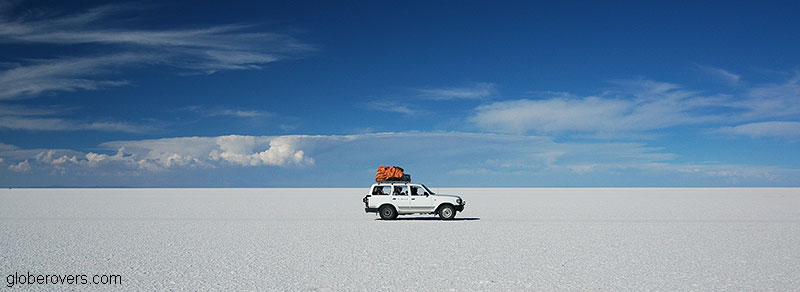
Salar de Uyuni in southwestern Bolivia is the world’s largest salt flats measuring more than 10,500 square km. Located at an altitude of 3,656 m above sea level in the Daniel Campos Province, this region is remote, unique, and inhospitable.
The best way to travel this area is to find a few buddies and rent a 4×4 vehicle with its driver. The tricky part of the journey is finding the right vehicle and the right driver. It is not unheard of to end up with a grumpy driver who has no interest in his passengers, and even of a driver who abandons his passengers and escapes over the horizon, with the vehicle of course! Choose wisely. Ask many questions and bargain to get a fair deal.
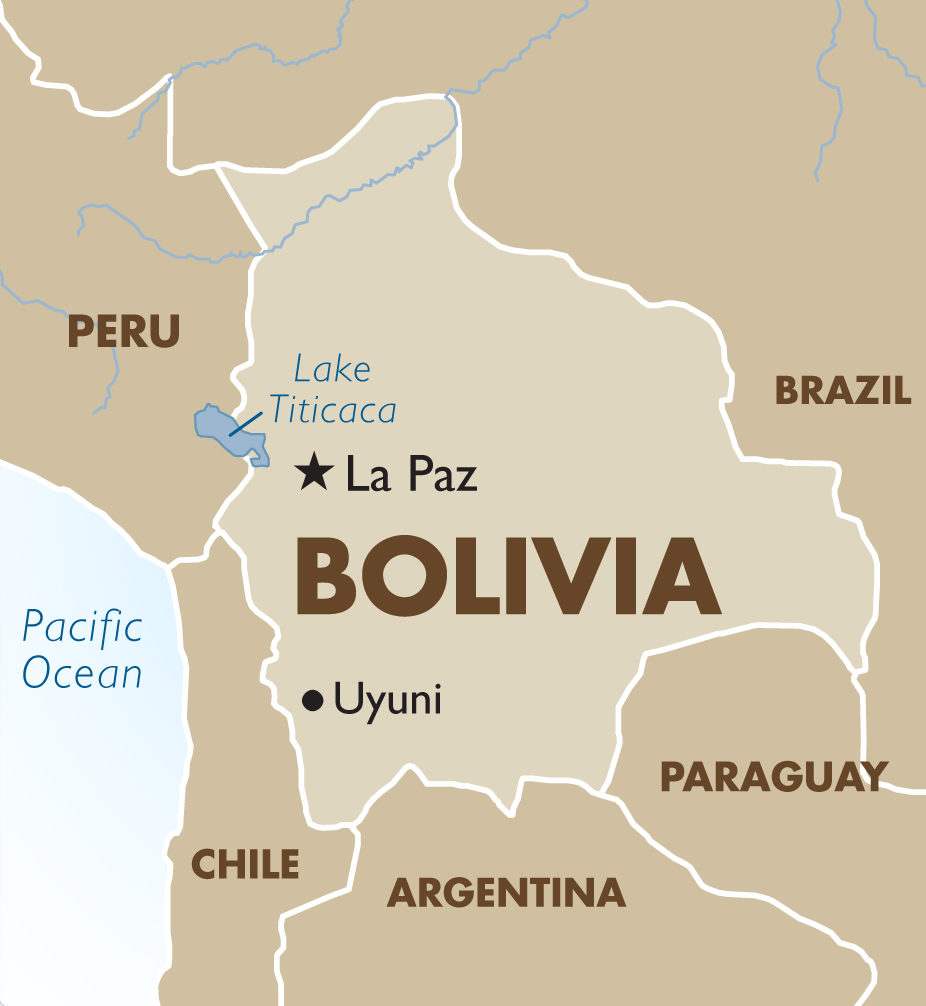
A good route is to start in the town of Uyuni where you should find the vehicles and drivers, and then head straight for the salar where you will stop at the salt hotel, Isla del Pescado (fish island), Isla Incahuasi, and drive over miles and miles of flat salt roads without any clear tracks.
Once you exit the salt flats to the south, you will come across many lakes, such Lago Cañapa, Lago Honda, Lago Colorada, and many more beautiful turquoise lakes, each with their flock of flamingos – James’s flamingo, Chilean flamingo, and the Andean flamingo. Early November is breeding time for the flamingos and they come in large numbers to feed on the pinkish coloured algae.
A remote region in the southwest corner of Bolivia known for the world’s largest salt flats, flamingos, extinct volcanoes, deserts, and turquoise lakes.
The area is known for its scenery with dormant volcanoes, turquoise lakes, weird rock formations, and its volcanic active areas with fierce fumaroles and boiling mud pots. While the salar is rather void of any noticeable life other than the odd tourist Landrover and the giant cacti on Isla del Pescado and Isla Incahuasi, the area off the salar has wildlife in abundance, if you have patience to search, and wait. The area is known to have about 80 bird species, including the flamingos, horned coot, Andean goose, and the Andean hillstar. Look out for the cute light-brown Andean fox, and the colonies of adorable rabbit-like viscachas which breed and live among the rocky outcrops.

Why Travel to Salar de Uyuni?
- The low-down: Southern Bolivia is a broad canvas to photographers, painters and adventurers. The entire area has surprises around every corner. The vast salt plains (Salar de Uyuni) is the cherry on this cake!
- The brightest highlight: The endless salt flats that stretch across a vast area is a sight to behold – whether its the dry season or rainy season.
- Intrepid destination: Most of the time the area is deserted. The perfect playground for intrepid travellers.
- Globerovers score (10 is highest): As one of the highlights of my travels around the world, southern Bolivia gets a 9.5/10.
Table of Contents
Vast Salt Flats
Salar de Uyuni (Uyuni Salt Flats) is part of the Altiplano high plateau of Bolivia, located on the South America continent. The plateau was formed during the uplift that also created the Andes mountains. The area is known for its fresh and saltwater lakes surrounded by mountains with no drainage outlet. As a result, some 40,000 years ago, the area was covered by over 150 m of water. It’s been claimed that the lake was formed as a result of the transformations between several prehistoric lakes. Over the years the lake started to dry up. The last recorded lake with a substantial amount of water was around 12,000 years ago.

Arrange a guide with 4WD vehicle in good condition in Uyuni or Tupiza for a 4 to 6 day trip to the Chile border.
It has been a vast and dry salt flat for quite some time. However, during the rainy season which is roughly from January to April, the local rainfall as well as overflows from Lake Titicaca in northern Bolivia at the border with Peru, floods much of Salar Uyuni.
So, while in the dry season it is nothing but a massive, yet very impressive dry salt flat, during the rainy season, particularly in January, it transforms into a vast water-filled lake. This temporary lake is only a few centimetres deep but the mirror reflections of the water on the salt makes for some spectacular photos. This is also the time when the roads off the salt get really muddy and difficult to navigate.

From near and afar, the vast salt flats seem totally flat. However, some crazy scientists have crisscrossed the salt with SUV’s sporting GPS antennas mounted to the roofs. They came to the conclusion that the flats did not exactly live up to their name. The highest elevated area is about 50 km away from the lowest area, and have a difference in elevation of 77 cm. Their theory explains that the highs and lows correspond to the local gravity field and the dissolving of the salt by rainwater which follows the curvature of the earth. Go figure!
Another theory is that the surface of the salt rises and falls to reflect the subsurface density variations. Whatever the correct theory is, this is one of the largest flat surfaces on our planet, and as a result it is being used to calibrate distance measurement devices aboard satellites.
The salt crust measures in thickness between just a few centimetres to a few metres. Containing 50% to 70% of the world’s highly prized chemical element lithium (a soft, silver-white metal used in lithium batteries), the area has been earmarked for massive mining operations. In addition to lithium, large amounts of sodium, potassium, and magnesium are also present.
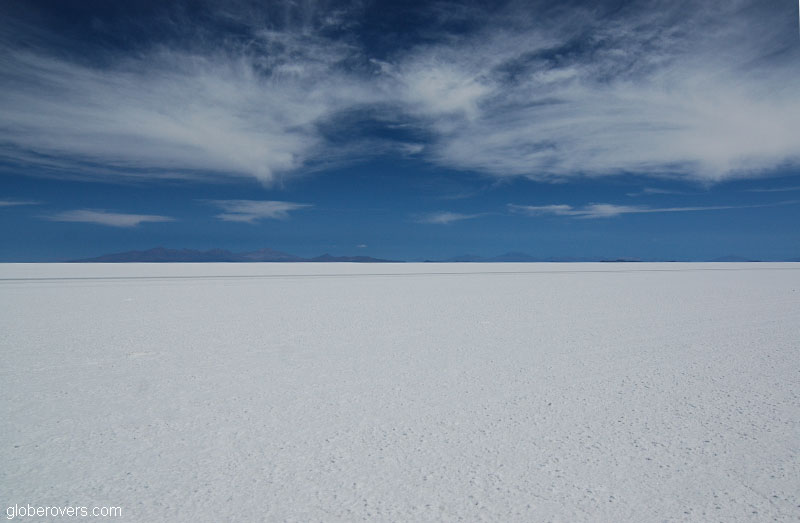
While the Bolivian government has long prevented foreign companies from possibly exploiting the area’s rich mining resources, in 2013 Bolivian President Evo Morales opened a $19 million lithium-production plant and told reporters that more than 60 percent of the profits from the lithium mining will stay within the country. It wasn’t long before the local mining companies realised that their lack of sophisticated equipment could not deliver the massive projected profits. So, they courted engineering firms from Germany and Switzerland.
There is much fear among the local indigenous Aymara people who have been harvesting the common table salt for ages, that mining on a large scale will seriously harm the area’s fragile ecosystem. Fortunately, no large scale mining has been launched yet, but who knows how it will change with the increasing demand for lithium by the growing demand for electric cars and mobile devices.
It is truly a wonderful experience just to gaze over the wide stretches of almost pure white salt.
Exit the trip to the east via Tupiza and then south on a stunning route to Argentina. Alternatively, exit to the south across the border of Chile to San Pedro de Atacama.
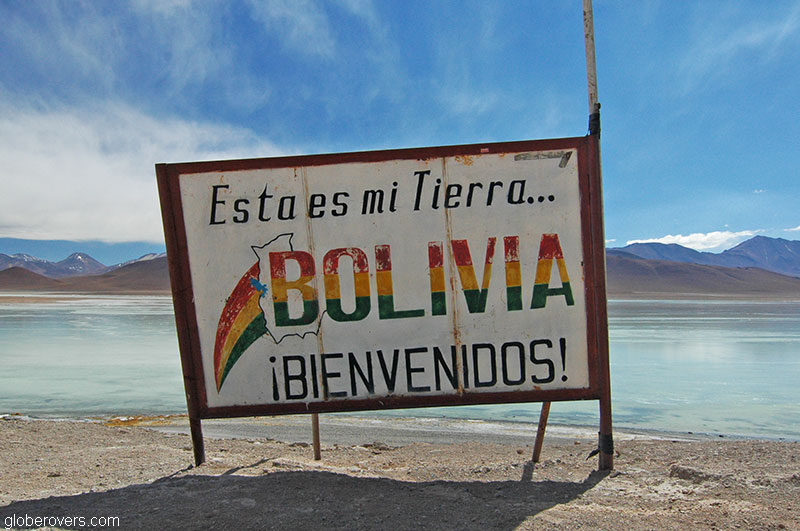
A Cacti Fish Island
Within Uyuni Salt Lake are several islands. They are the summits of pre-historic volcanoes from the days when this was still a massive and deep lake. Each island is home to its own fragile ecosystem.
Among the most prominent islands is Isla Incahuasi (3,687 m), a hilly and rocky outcrop. Isla is the Spanish word for “island”, while Inca refers to the Indian “Inca” tribe, and huasi is derived from the Quechua-language word “wasi” which means a house. However, a more apt name is Cactus Island as the almost 25 hectares’ outcrop is covered in tall, slow-growing, columnar, gigantic cacti, Echinopsis atacamensis.
Isla Incahuasi is also home to colonies of rabbit-like long-tailed rodents called viscachas. You will also find fragile coral-like structures, fossils and algae.

A neighbouring island, Isla del Pescado (Fish Island) at 3,726 m, is the largest of these islands. It derives its name from its ellipsoid shape when viewed from the east or west. This island is also home to the viscachas, and cacti, some of which can measure more than 10 m in height, referred to as “thousand-year-old giant cacti”.
On the sides of the islands, terraces mark the level of ancient lakes, and in some places, fossilised algae can be seen covering the rocks.
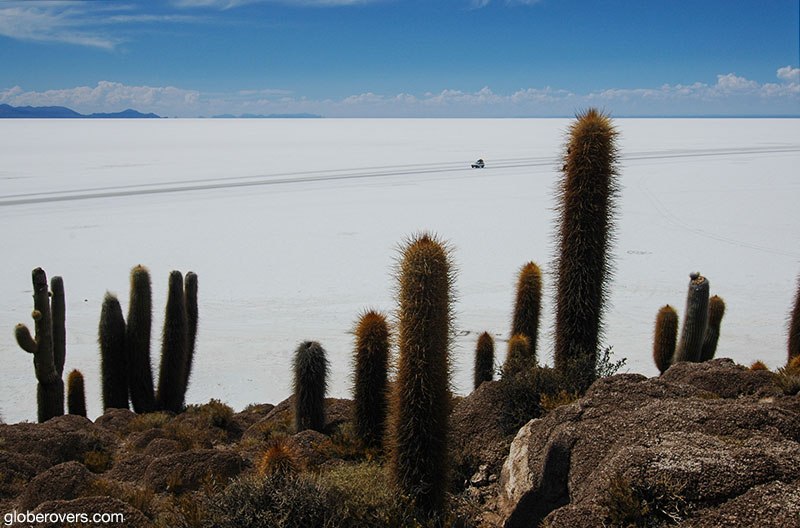
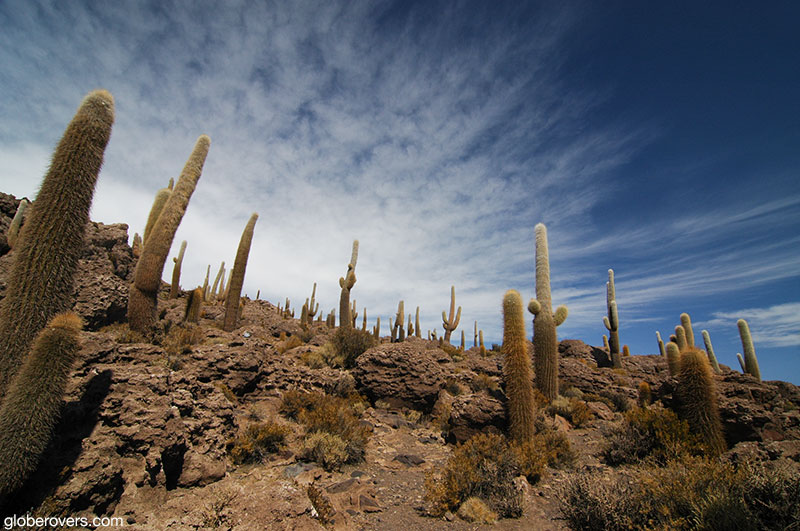
Wildlife
The most impressive wildlife in this part of the world are the flamingos. Many flamingos. James’s flamingo, Chilean flamingo, and the Andean flamingo. Early November is breeding time for the flamingos and they come in large numbers to feed on the pinkish coloured algae.
The flamingos have likely never been hunted and don’t seem to be too scared of a human presence, which means you can sneak up fairly close to them before they fly away. It’s truly an incredible sight to see hundreds, if not thousands, of these pinkish-red birds grazing in the shallow lakes with white borax edges and reddish islands. The only thing more beautiful, is when they en masse take to flight right in front of your very eyes.
Among the other 80 bird species reported in the area, are the horned coot, Andean goose, and the Andean hillstar. Some llamas, alpacas, and vicuñas graze at the edges of the lakes. You may also see the light brown Andean fox, and it is hard to miss the colonies of adorable rabbit-like viscachas which breed and live among the rocky outcrops.
Llamas are also common in this area.
☛ Read more: Wildlife of southern Bolivia
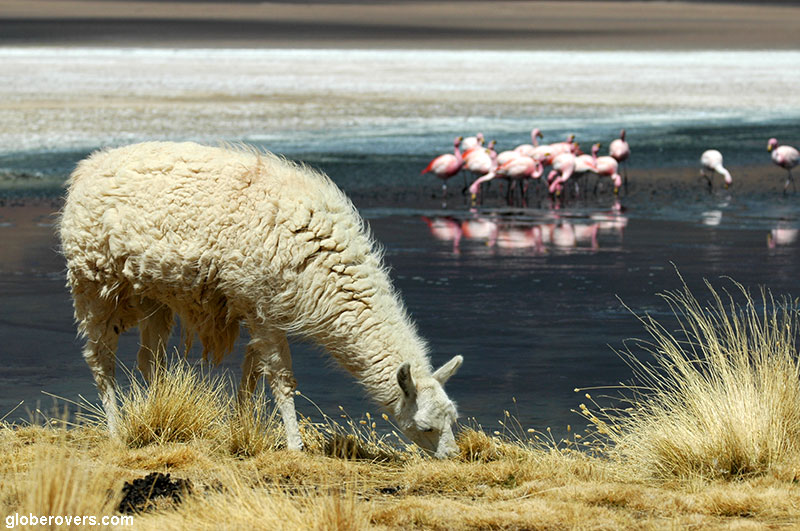
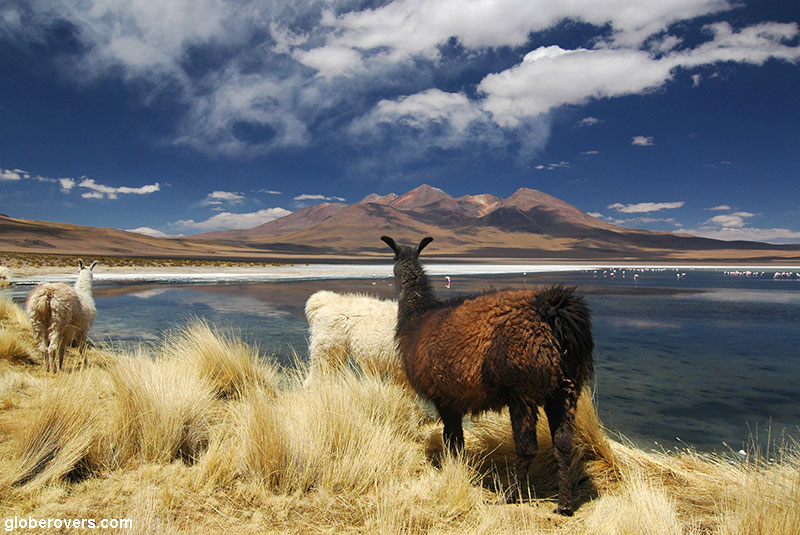
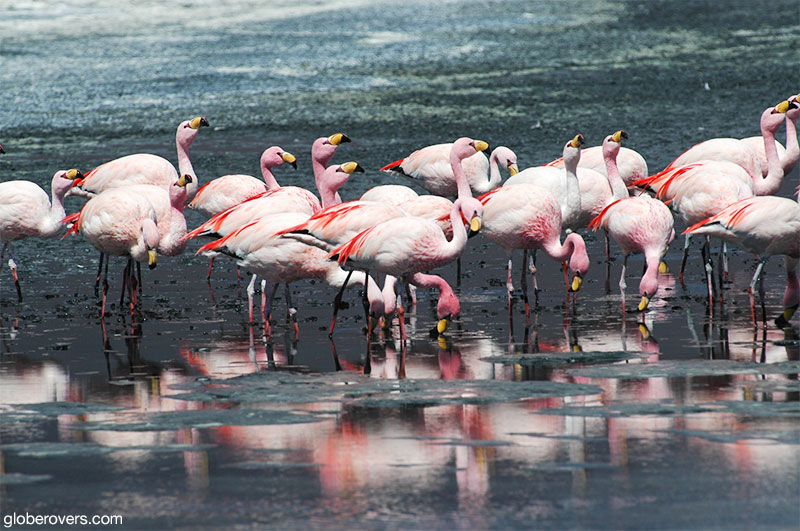
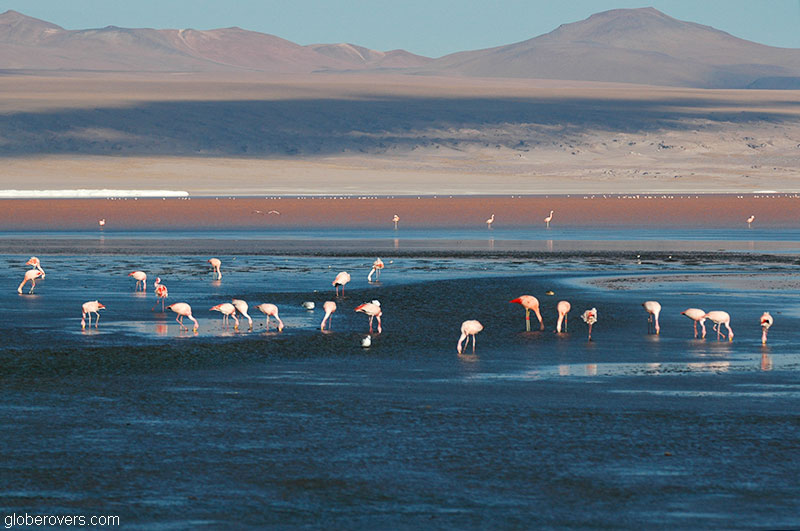
Volcanos, Lakes, and Rocks
Southwestern Bolivia sits on the Altiplano tectonic plate which has some of the world’s highest volcanoes. Most volcanoes are located along the border with Chile which is part of the so-called “ring of fire”. The volcanoes run from Chile in the south to Peru in the north.
While most of the volcanoes here are not extremely active, they continuously show that they are more alive than dormant.
Volcan Uturuncu in the south, east of the Chilean border, has recently been described as a new super-volcano in the making.
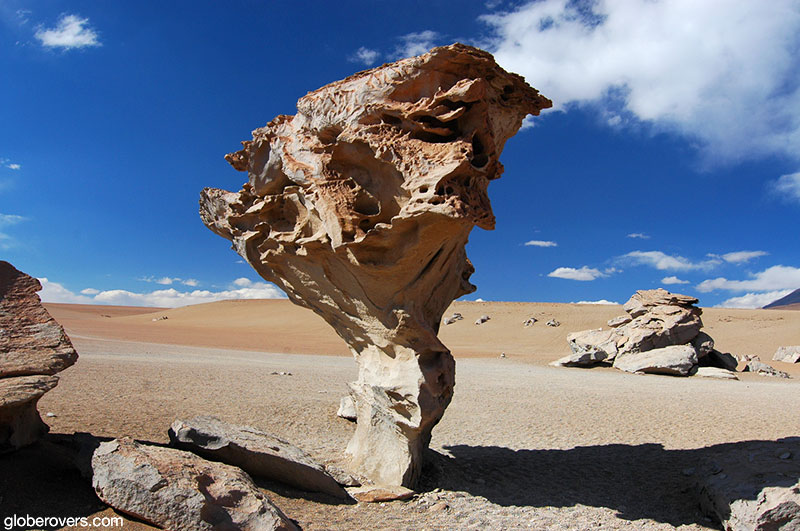
Eduardo Avaroa Andean Fauna National Reserve, Sur Lípez Province.
The area is also known for its beautiful rock formations. Some are located on the islands inside Salar de Uyuni, while others are in the deserts.
To the north of Laguna Colorada, in the Pampas de Siloli, is the Arbol de Piedra, a large rock sculpted by the wind into the shape of a tree. Over many years of strong winds across the desert, the sand has sculpted the rocks into beautiful formations. The Siloli desert is considered a part of the Atacama Desert and is one of the most arid in the world, due to low precipitation that occurs in the area. The conical-shaped extinct volcanoes, red desert, and sculpted rocks all make beautiful scenery.
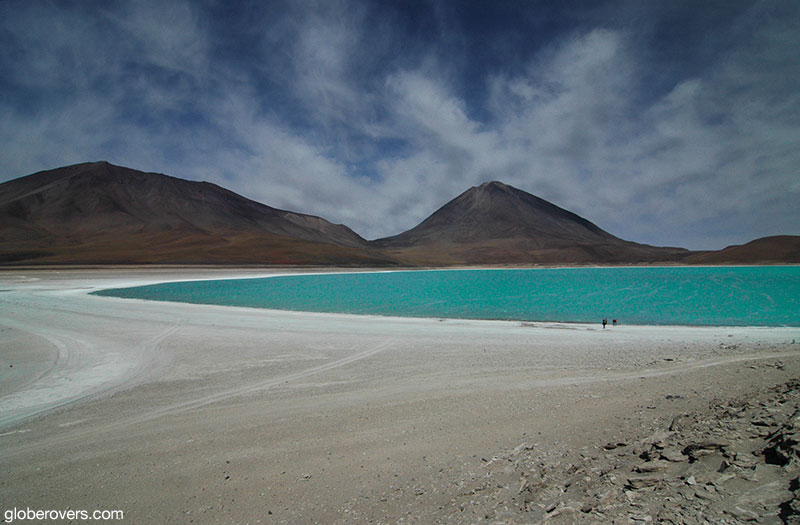
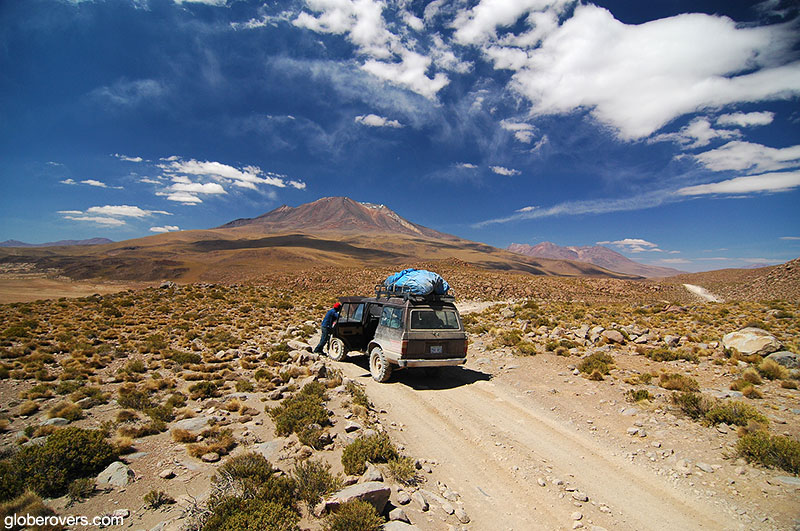

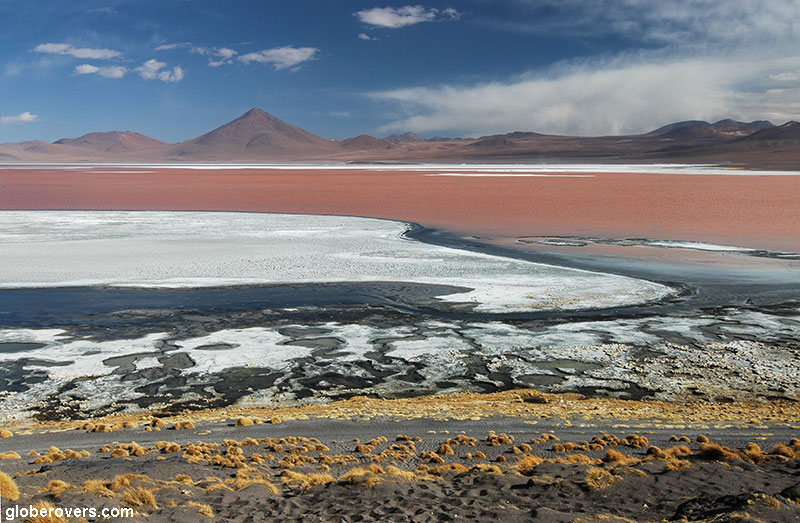
Thermal Activity and Hot springs
Nothing as good as soaking in hot springs with nothing but flamingos and dormant volcanoes around you! Oh, and the odd llama and alpaca grazing nearby along the shores of the turquoise lake. Feel free to do it the natural way. There is probably nobody nearby, except a friend, if you brought your own.
The hot springs here are unmarked without any signage indicating where to swim. Walk along the lake, watch out for spurts of hot water, until you find a nice clean and warm pool. Slip off the jeans and pop right in. Early in the mornings, almost year-round, it is cold to very cold. But, once you are in the hot water, just lay back and enjoy the feeling and the stunning scenery around you. The flamingos, the llamas, alpacas, and snow-capped conical-shaped dormant volcanoes. Life is good!
The pungent smell of sulphur combined with the 4,849 m altitude, can make some people feel dizzy and sick.
Nearby, in the northwest corner of Eduardo Avaroa Andean Fauna National Reserve, to the south of Laguna Colorada, is one of the highlights. Sol de Mañana is an area of geothermal activity with boiling mud pots and fumaroles.
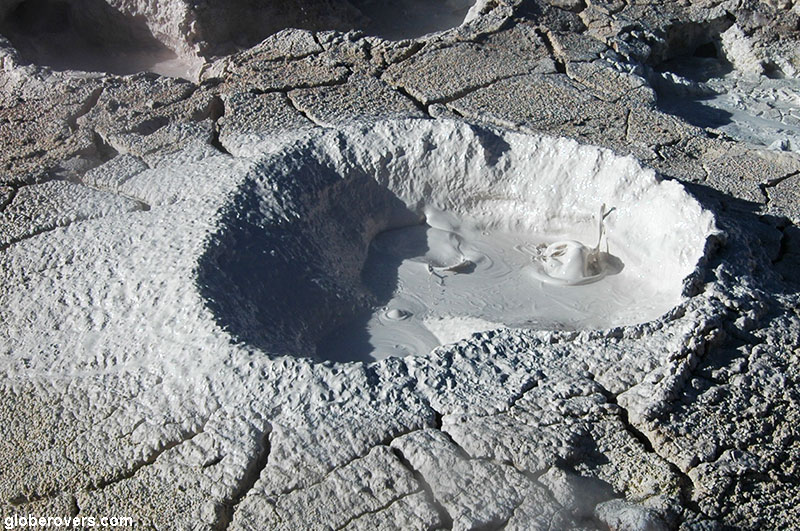
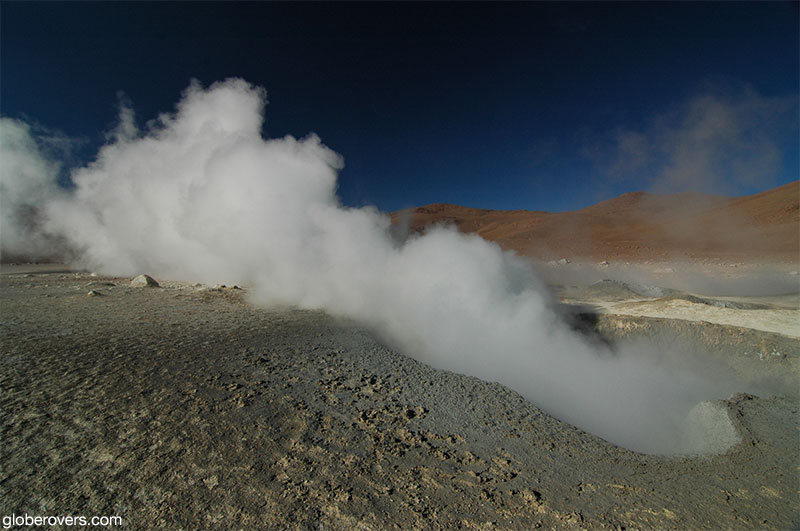
However, if you can stand the stench, and the thought that should you slip into a boiling mud pot you will instantly become part of the soup, then you should enjoy the experience.
This is raw nature at its best.
There is no visitor’s centre, no safety railings, or even directions. Should you arrive alone, then you will be alone. Do not fall into a mud pot because nobody will come to your rescue. The next tourist to arrive will discover your soft-cooked body in the soup.
The fumaroles emit highly pressurised steam with a strong hissing sound. Some of them are strong enough to shoot up to about 50 m high.
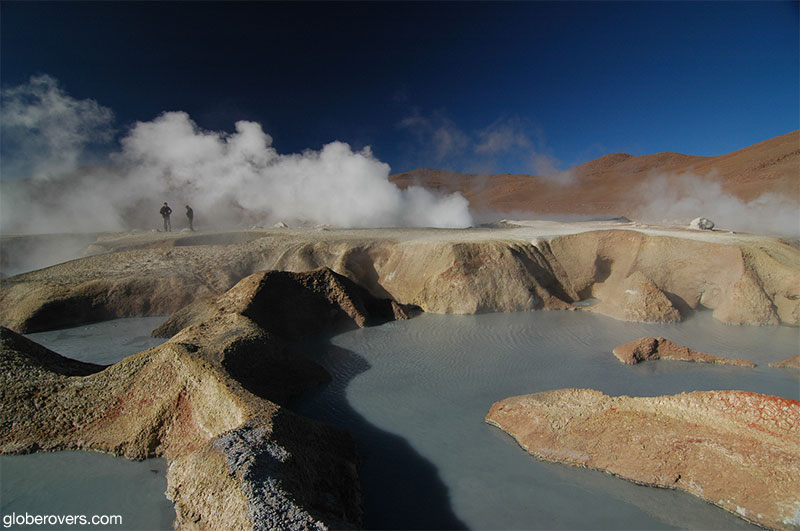
In addition to the fumaroles and the boiling mud pots, there are also mud lakes and steam pools. There are no geysers which intermittently discharge boiling water, ejected turbulently and accompanied by steam.
The thermal active area extends over about 10 square km, so spend an hour or two walking around and appreciating our active planet.
It is not clear if the government will go ahead with a planned geothermal electricity-generating project for this area, which will destroy its natural beauty.

The Salt Hotels
With durable, rock-hard salt in abundance, no wonder you can stay in a hotel built with salt carved from the crust.
The first salt hotel, Hotel de Sal Playa Blanca, was built in 1993 almost in the middle of Salar de Uyuni. Consisting of 15 bedrooms, a dining room, living room, bar, common bathroom and no showers, it became popular. Due to sanitation difficulties and a threat to the fragile environment it was forced to dismantle.
If you stay here, follow the house-rules of “No licking of the walls”, to prevent their degradation.
Then in 2007 a new hotel, Palacio de Sal, was built at the eastern edge of the salt flat, just 25 km from Uyuni town. Constructed with about a million blocks of salt, cut into 35 cm pieces, almost the entire building, including the furniture and sculptures were completed within a short time. The sanitary system now complies with strict government regulations.
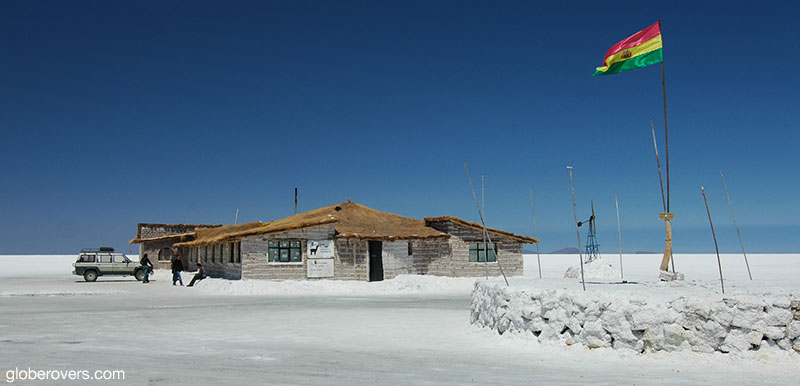

Salar de Uyuni these days boasts more than one salt hotel. Check out Hotel de Sal Luna Salada to the northwest of Uyuni town, as well as Hotel de Sal Cristal Samaña a few kilometres south.
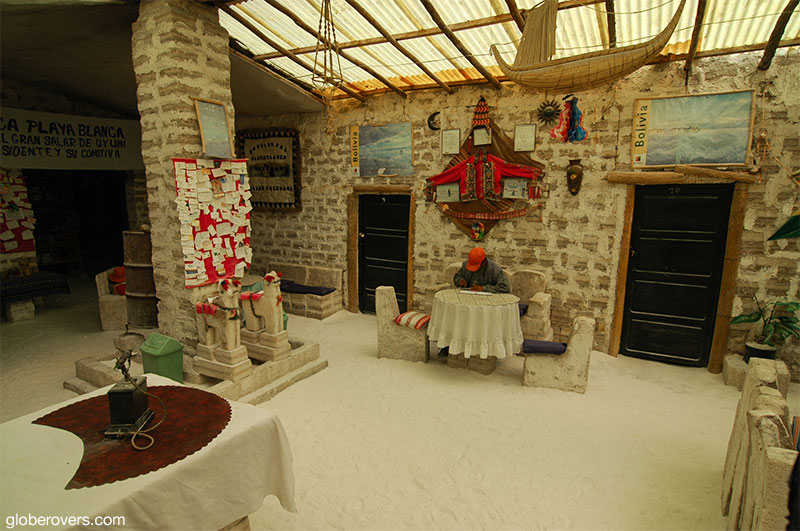
The Train Cemetery
It is not every day that you see a train cemetery in the middle of nowhere! About 3 km outside the town of Uyuni is the rather bizarre scenery of rusted old trains, still on their rusty tracks.
The “antique train cemetery“ (“Cementerio de trenes” in Spanish) has an interesting history.
A very long time ago, Uyuni used to be the hub for trains moving minerals to the Pacific Ocean ports of Chile.
The rail lines were built by the British from 1888 and completed in 1892. However, the local Aymara indigenous Indians were not impressed with the trains and frequently sabotaged the tracks.

When the mining companies collapsed during WWII, the trains were moved outside town and left to die a rusty death!
The train cars and locomotives date back to the early 20th century and are being slowly eroded by strong salty winds blowing relentlessly.
There are no restrictions or entrance fees, so climb around and do your yoga tricks, but be careful and don’t get cut by rusty or falling metals.

Essential Information
Getting There
There are three main entry points to Salar de Uyuni. The town of Uyuni is the most popular starting point, but also consider Tupiza in the east or San Pedro de Atacama in the south on the Chile side. From Argentina, an infrequent train runs to Uyuni. However, the route is very scenic so consider a 4×4 with a driver.
Getting Around
Once you have your vehicle and driver booked, just stay with them and you are all set. No need for any additional transportation other than hiking boots. If you start in the town of Uyuni, you can end in the far south and then take a bus to San Pedro de Atacama. From here go to Salta in Argentina, or travel through Chile.
Location
Salar de Uyuni is located in southwestern Bolivia. Depending on the entry point where you rent the vehicle and driver, you may be coming from Argentina or Chile in the south, or from Peru in the north via places such as La Paz, Sucre, or Potosi. Bolivia is one of the most incredible countries in the world! Undeniably!
When to Go
Dry season (May to December) is a great time to visit. May to September can be very cold, particularly at night. Wet season (January to March) is great for reflections on the water but travel areas may be very restricted.
Where to Stay
Best is to leave accommodation decisions and bookings up to your driver but do make sure you discuss the sleeping options. Accommodation is mostly basic in large rooms with several beds.
Packing
Year-round the nights can get quite cool. From around May to September, daytime temperatures can be cold and at night, very cold. Come with a good sleeping bag and thermal underwear.
Dining Out
Once you have left the town of entry the only dining out will be at the basic guesthouses. Normally breakfast and dinner are included in the package tour. Food is basic but at the end of the day, you will eat anything.
Train Journeys
The only trains in this area no longer accept passengers. If you are a train lover, go and pay your respects at the train cemetery outside Uyuni town. Currently, a passenger train runs north and south from Uyuni.
Cost of Travel
It is best to shop around at the town of entry (Uyuni, Tupiza, or San Pedro de Atacama). Bargain hard but do check the details such as accommodation, meals, vehicle, route, entry / exit points, and group size.
☛ Read more: 9 Sights not to miss in southern Bolivia
☛ Read more: Wildlife of southern Bolivia

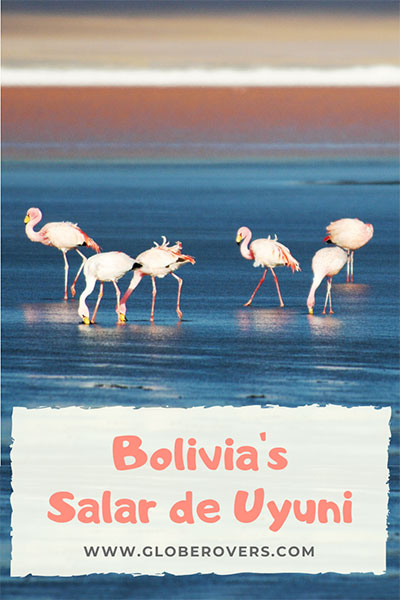
Further reading
- 9 Sights not to miss in southern Bolivia
- 9 Must-do destinations in South America
- Peru’s Sacred Valley of the Incas

Blog post and photos by Peter who has been travelling almost full-time since 2005 and has been to over 122 countries. He visited several countries, such as Japan, more than 20 times. Peter is Editor-in-Chief and Publisher of GlobeRovers Magazine, an independent travel magazine focused on intrepid destinations.
